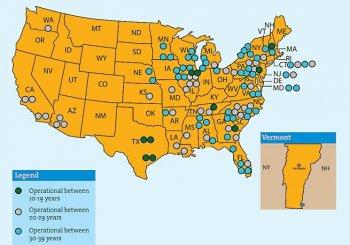Sen. Kerry introduced a new bill that would help reduce youth homelessness in the United States, last Thursday.
“As a father, it’s a punch in the gut to imagine children living on the streets, but this year alone, one in fifty American kids will be homeless,” Sen. Kerry said in a statement. “There are common-sense reforms we can implement to help make things better.”
The bill, called the Reconnecting Youth to Prevent Homelessness Act allows youth to stay in foster care until they are 21, among other measures. Currently, some 30,000 youth age 16 or older “age out” at 18 or gain “legal emancipation” from foster care programs. Of these, one in four goes on to experience homelessness within four years of exiting foster care.
The legislation also provides support for states to work together to decrease barriers that prohibit cooperation across state borders for giving foster children homes in different states.
Additionally, the bill would extend the amount of time that youth can access the Chafee Foster Care Independence Program—a program that helps youth gain self-sufficiency through help with education, employment, housing, emotional, and financial management skills.
The bill would also improve the Temporary Assistance to Needy Families (TANF) program by helping families get in touch with educational, training, and housing resources. TANF tries to help family members become better caretakers. It also promotes preparation for work and marriage through various programs, hoping to eliminate out-of-wedlock pregnancies and encourage the formation of two-parent families.
While the exact number of youth suffering from homelessness in the United States is unknown, a 2009 figure from the Department of Housing and Urban Development puts a conservative estimate at 22,700. Other sources, however, estimate some 110,000 youth are homelessness, living on the streets, in cars, or in abandoned buildings. The Department of Education states that there are 53,000 unaccompanied youths who are supported through school-based programs.
Out of those interviewed in a study by the U.S. Department of Health and Human Services, more than half reported their parents either told them to leave or knew that they were leaving and did nothing. Some 46 percent of homeless youth have been physically abused and 17 percent had been forced into unwanted sexual activity by a relative or household member.
Considering that most aid programs are geared toward adults, homeless youth often find themselves in difficult situations with nowhere to go. The National Coalition for the Homeless reports, “Because of their age, homeless youth have few legal means by which they can earn enough money to meet basic needs. Many homeless adolescents find that exchanging sex for food, clothing, and shelter is their only chance of survival on the streets.”
The United States Interagency Council on Homelessness points out six areas that should be improved in addressing youth homelessness. Homeless youth would benefit from programs that would first meet their immediate needs and then address other aspects of their lives.
For instance, because many schools have guardianship and residency requirements, many homeless youth cannot attend school and receive the educational training they need for gaining self-sufficiency. Programs that train youth in independent living skills and provide them with access to a supportive adult network, employment and housing could be beneficial.
“As a father, it’s a punch in the gut to imagine children living on the streets, but this year alone, one in fifty American kids will be homeless,” Sen. Kerry said in a statement. “There are common-sense reforms we can implement to help make things better.”
The bill, called the Reconnecting Youth to Prevent Homelessness Act allows youth to stay in foster care until they are 21, among other measures. Currently, some 30,000 youth age 16 or older “age out” at 18 or gain “legal emancipation” from foster care programs. Of these, one in four goes on to experience homelessness within four years of exiting foster care.
The legislation also provides support for states to work together to decrease barriers that prohibit cooperation across state borders for giving foster children homes in different states.
Additionally, the bill would extend the amount of time that youth can access the Chafee Foster Care Independence Program—a program that helps youth gain self-sufficiency through help with education, employment, housing, emotional, and financial management skills.
The bill would also improve the Temporary Assistance to Needy Families (TANF) program by helping families get in touch with educational, training, and housing resources. TANF tries to help family members become better caretakers. It also promotes preparation for work and marriage through various programs, hoping to eliminate out-of-wedlock pregnancies and encourage the formation of two-parent families.
While the exact number of youth suffering from homelessness in the United States is unknown, a 2009 figure from the Department of Housing and Urban Development puts a conservative estimate at 22,700. Other sources, however, estimate some 110,000 youth are homelessness, living on the streets, in cars, or in abandoned buildings. The Department of Education states that there are 53,000 unaccompanied youths who are supported through school-based programs.
Out of those interviewed in a study by the U.S. Department of Health and Human Services, more than half reported their parents either told them to leave or knew that they were leaving and did nothing. Some 46 percent of homeless youth have been physically abused and 17 percent had been forced into unwanted sexual activity by a relative or household member.
Considering that most aid programs are geared toward adults, homeless youth often find themselves in difficult situations with nowhere to go. The National Coalition for the Homeless reports, “Because of their age, homeless youth have few legal means by which they can earn enough money to meet basic needs. Many homeless adolescents find that exchanging sex for food, clothing, and shelter is their only chance of survival on the streets.”
The United States Interagency Council on Homelessness points out six areas that should be improved in addressing youth homelessness. Homeless youth would benefit from programs that would first meet their immediate needs and then address other aspects of their lives.
For instance, because many schools have guardianship and residency requirements, many homeless youth cannot attend school and receive the educational training they need for gaining self-sufficiency. Programs that train youth in independent living skills and provide them with access to a supportive adult network, employment and housing could be beneficial.




